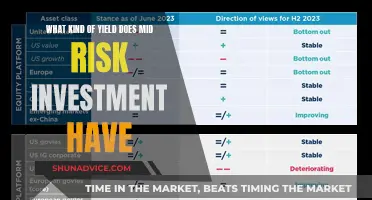
Tactical investment managers are those who take an active role in managing their clients' portfolios, adapting to changing market conditions and striving to outperform stated benchmarks. This approach is in contrast to passive investing, which involves setting allocations to indices and letting them ride. Tactical investment managers aim to create alpha, or the excess return of an investment relative to a benchmark, by seeking opportunities in the markets and managing risk exposures during negative market cycles. This involves making short-term investment decisions based on anticipated near-term price movements in a security or market sector. Tactical investment managers may use a range of resources, including technical charts and fundamental analysis, to identify both short and intermediate profit opportunities. While tactical investment management can offer the potential for higher returns, it also comes with higher risks and may involve more complex strategies than standard long-term investing approaches.
What You'll Learn
- Tactical investment managers are active managers who adapt to changing environments
- Tactical asset allocation involves adjusting long-term targets for short-term gains
- Tactical managers aim to create alpha and manage risk
- Tactical investment management is a supplement to the traditional buy-and-hold approach
- Tactical management uses trend-following or sector rotation approaches

Tactical investment managers are active managers who adapt to changing environments
Tactical investment managers are also distinct from strategic investment managers. Strategic investment managers follow a long-term plan, consistently executed. For example, a strategic investment manager may invest in stocks that they believe are underpriced, or they may invest primarily in securities that pay above-average yields. Tactical investment managers, on the other hand, take a more flexible approach, changing their investment mix more frequently in response to market trends and conditions.
Tactical investment managers tend to use one of two approaches: trend-following or sector rotation. These approaches are largely based on technical indicators. However, research has shown that the market is relatively efficient, and such simplistic approaches are unlikely to work consistently over time. Therefore, rational investors must consider forward-looking expectations of returns and risks, and tactical investment managers must optimise near-term risk-return forecasts for major asset classes.
Tactical investment management has been gaining traction since the early 2010s. In 2012, a survey showed that the percentage of pension managers pursuing a combined "strategic and tactical" approach increased to the 40% to 50% range, up from a single-digit percentage ten years prior.
Understanding Discretionary Investment Management Agreements
You may want to see also

Tactical asset allocation involves adjusting long-term targets for short-term gains
Tactical investment managers are those who actively manage their portfolios and adapt to changing environments. They do not simply accept what the market provides but instead, they seek to create alpha and manage risk. Tactical asset allocation (TAA) is a strategy used by these managers to shift the percentage of assets held in various categories to take advantage of market pricing anomalies or strong market sectors.
TAA is an active management portfolio strategy that involves adjusting long-term target weights for a short period to capitalize on market or economic opportunities. It is considered a moderately active strategy as managers return to the portfolio's original asset mix once the desired short-term profits are achieved. This strategy allows portfolio managers to create extra value by taking advantage of certain situations in the marketplace.
TAA is different from strategic asset allocation, which involves setting target allocations across various asset classes and regularly rebalancing the portfolio to stay close to the assigned allocation through all market conditions. While strategic asset allocation is a more passive, long-term approach, TAA encourages adjustments to a portfolio's asset mix based on short-term market forecasts and perceived inefficiencies or temporary imbalances in values among different asset classes.
TAA can be either discretionary or systematic. In a discretionary TAA, an investor adjusts asset allocation according to market valuations and changes in the same market as the investment. On the other hand, a systematic TAA uses a quantitative investment model to take advantage of inefficiencies or temporary imbalances among different asset classes, backed by academic and practitioner research.
TAA involves making tactical shifts, which typically range from 5% to 10%, within an asset class. For example, if the outlook for small-cap stocks does not look favourable, a tactical decision may be to shift the allocation within stocks towards large-cap stocks for a short time until conditions change.
Overall, TAA is a useful strategy for tactical investment managers as it allows them to be flexible and take advantage of short-term opportunities in the market while still maintaining a long-term focus.
Investment Management: Competitive or Cutthroat?
You may want to see also

Tactical managers aim to create alpha and manage risk
Tactical investment managers aim to create alpha and manage risk. This means they strive to beat their benchmarks by seeking opportunities in the markets and/or managing risk exposures during negative market cycles.
Tactical managers do not simply accept what the market provides; they actively manage their portfolios and adapt to changing environments. They do not just set their portfolio allocation and let the market decide the outcome. Instead, they are focused on timing, selection, and leverage – when to buy and sell, what to buy and sell, and how much to buy and sell.
Tactical investment managers take a dynamic approach, making short-term investment decisions based on anticipated near-term price movements in a security or market sector. They may take long or short positions in a wide range of markets and asset classes, including equities, fixed income, commodities, and currencies.
Tactical investment management is a form of active management, which has been gaining traction since the early 2010s. It is a response to the potential shortcomings of the traditional buy-and-hold strategy, which some believe may not work well going forward due to overvalued stocks and the risk presented by low-interest rates.
Understanding Management Investment Trusts: What You Need to Know
You may want to see also

Tactical investment management is a supplement to the traditional buy-and-hold approach
Tactical investment management is a form of active management that involves forecasting and optimising near-term risk-return forecasts for major asset classes. Tactical managers use technical analysis to identify short- and intermediate-term profit opportunities. They take long or short positions in a range of markets, from equities and fixed income to commodities and currencies, based on anticipated market trends or short-lived changes in outlook.
Tactical investment management is often used as a supplement to a broader strategic asset allocation strategy. It involves making tactical shifts in a portfolio's asset mix based on short-term market forecasts to exploit inefficiencies or temporary imbalances in values among different asset classes. These tactical shifts are typically in the range of 5% to 10% and are made with the intention of reverting to the original asset mix once short-term profits are achieved.
Tactical investment management can be a useful tool to improve performance by changing the investment mix more frequently. For example, a stock fund manager may quickly shift a large portion of their portfolio to more blue-chip names if they believe more speculative stocks are falling out of favour. However, tactical shifts can be challenging to get right consistently and may result in higher trading costs.
Saving and Investing: Biblical Principles for Financial Wisdom
You may want to see also

Tactical management uses trend-following or sector rotation approaches
Tactical investment managers are those who actively manage their portfolios and adapt to changing environments, as opposed to passive investors who set their portfolios and let the market fluctuate. Tactical managers aim to create alpha, or excess returns relative to a benchmark, and manage risk.
Tactical management has been gaining popularity since the early 2010s, with an increasing number of pension managers adopting a combined "strategic and tactical" approach. Tactical asset allocation is a form of active management that involves adjusting long-term target weights for a short period to capitalise on market or economic opportunities.
Sector rotation involves shifting the percentage of assets held in various categories to take advantage of market pricing anomalies or strong market sectors. This allows managers to create extra value by exploiting certain situations in the marketplace. For example, if data suggests that there will be a substantial increase in demand for commodities over the next 18 months, an investor may shift more capital into that asset class to take advantage of the opportunity.
While tactical management can be a useful tool, it is important to note that it can be challenging to implement successfully. Research has shown that tactical shifts in portfolios, or market timing, can be counterproductive over time. It is difficult to consistently make the right decisions at the right time, and the added complexity and higher risks of tactical management can lead to higher trading costs and potential losses.
Savings, Investment, and Productivity: The Interplay for Economic Growth
You may want to see also
Frequently asked questions
A tactical investment manager is an investment manager who actively manages their clients' portfolios by adapting to changing market environments and seeking opportunities to improve performance. Tactical investment managers do not simply accept what the market provides but instead aim to create "alpha", or the excess return of an investment relative to the return of a benchmark.
Tactical investment managers use three portfolio "levers" to create alpha: timing (when to buy and sell), selection (what to buy and sell), and leverage (how much to buy and sell).
Unlike passive investment management, which involves setting allocations to indices and letting them ride, tactical investment management involves actively seeking opportunities in the markets and/or managing risk exposures during negative market cycles. Tactical investment management aims to outperform stated benchmarks, while passive investment management does not.
Tactical investment management can be beneficial in a few ways. Firstly, it can help to improve performance by taking advantage of market opportunities and adjusting to changing market conditions. Secondly, it can help to manage risk by not simply accepting what the market provides. Lastly, it can provide more flexibility and adaptability compared to passive investment management.







